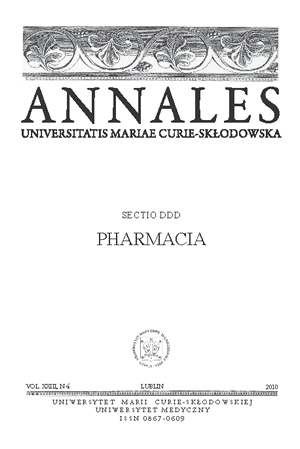Effect of Pb2+ upon antioxidant enzymes activity of rat lymphocytes
Keywords:
Pb2+, lymphocytes, lipid peroxidation, antioxidant systemAbstract
The main aim of the present study was to investigate the effect of Pb2+ upon antioxidant enzymes activity of rat lymphocytes after the single dosing lead acetate. It was established that under the influence of lead cations the activities of superoxide dismutase and glutathione reductase decreased, while glutathione peroxidase activity did not change significantly. These effects were accompanied by accumulation of the products of lipid peroxidation (malondialdehyde and lipid hydroperoxides) in rats’ lymphocytes during the initial period of intoxication with heavy metal and normalisation of their concentrations on the 10th day after injection.
References
1. Beckman K., Ames B.N.: The free radical theory of aging matures. Physiol. Rev., 78, 547, 1998.
2. Biser J.A., Vogel L.A., Berger J. et al.: Effects of heavy metals on immunocompetence of white-footed mice (Peromyscus leucopus). J. Wildlife Dis., 40, 173, 2004.
3. Boyum A.A.: A one- stage procedure for isolation of granulocytes and lymphocytes from human blood. Scand. J. Clin. Lab. Invest., 21, 51, 1968.
4. Droge W.: Free radicals in the physiological control of cell function. Physiol. Rev., 82, 47, 2002.
5. Dubinina E.E., Salnikova L.A., Efimova L.F.: Activity and isoenzymatic spectrum of SOD of human erythrocytes. Lab. Affair, 10, 30, 1983.
6. Jurczuk M., Moniuszko-Jakoniuk J., Brzoska M.: Involvement of some low-molecular thiols in the peroxidative mechanisms of lead and ethanol action on rat liver and kidney. Toxicol., 219, 11, 2006.
7. Koller L.D.: The immunotoxic effects of lead in lead-exposed laboratory animals. In: Annals of the New York Academy of Sciences. G.T.Keusch, A.Cerami, and F.Takaku (eds.). New York Academy of Sciences, 587, 160, 1990.
8. Korobeinikov E.N.: Modification of the measurence. Lab. Affair, 7, 8, 1989.
9. Moin V.M.: Simple method of the measurence glutathione peroxidase activity of the erythrocytes. Lab. Affair, 12, 724, 1986.
10. Needleman H.: Lead poisoning. Ann. Rev. Med., 55, 209, 2004.
11. Orechovich V.N.: Modern biochemical methods. M: Medicine, 391, 1977.
12. Pagliara P., Carla E.C., Caforio S. et al.: Kupffer cells promote lead nitrate-induced hepatocyte apoptosis via oxidative stress. Comp. Hepatol., 2, 8, 2003.
13. Pershyn O.I., Antonyak H.L.: Effects of lead cations on lipid peroxidation and activities of enzymes of antioxidant system in erythrocytes of white rats. Exp. Clin. Physiol. Biochem., 3, 19, 2005.
14. Pinto R.E., Bartley W.: The effect of age and sex on glutathione reductase and glutathione peroxidase activities and on aerobic glutathione oxidation in rat liver homogenates. Biochem. J., 112, 109, 1969.
15. Umansky V., Rocha M., Breitkreutz R. et al.: Glutathione is a factor of resistance of Jurkat leukemia cells to nitric oxide-mediated apoptosis. J. Cell. Biochem., 78, 578, 2000.
Downloads
Published
Issue
Section
License
Copyright (c) 2010 Authors

This work is licensed under a Creative Commons Attribution-NonCommercial-NoDerivatives 3.0 Unported License.


